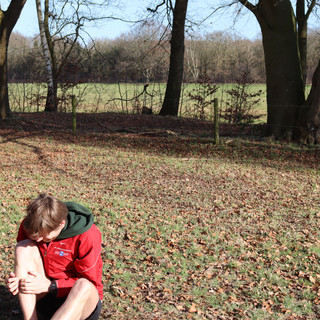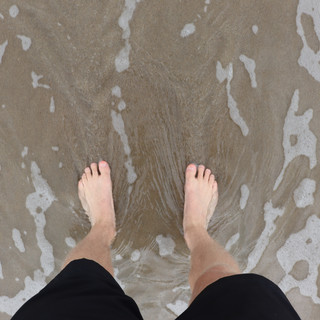Runner's Knee
- Mick van Eeuwijk
- May 6, 2021
- 7 min read
Updated: Jul 20, 2021
'Running is painful. Especially when I run uphill. Around and behind my knee cap I feel a pain. The pain is difficult to describe though. If I have to label the pain I would say achy and sometimes sharp.'
When this story sounds familiar, good chance that you have a runner's knee.

Runner's knee vs Patellofemoral Pain Syndrome
A runner's knee is the same as patellofemoral pain syndrome (PFPS). PFPS is a broad term to define pain around or behind the knee cap. Other words for a runner's knee are: retropatellar pain syndrome, lateral facet compression syndrome or idiopathic anterior knee pain.
PFPS is a diagnosis of exclusion. This means that all other possible injuries in the knee are not possible and therefore it has to be PFPS.
PFPS is a very broad term, because it is not entirely clear what exactly hurts or is damaged when you have a runner's knee. Some scientists suggest that there is a microdammage or inflammation of the knee cap. The following components of the knee could be affected: subchondral bone, synoniem, retinaculum, skin, nerve, and muscle.
A runner's knee could come up gradually or acute. A prior injury to the runner's knee could also be the cause of a runner's knee.
Do I have a runner's knee?
Running, squatting and going up and down the stairs are the typical activities which are painful when you have runner's knee.
The physiotherapy test for runner's knee is to squat. While squatting the pressure increases in the knees. This provokes the typical runner's knee pain.
Another sign of runners knee is that staying seated for a longer period of time is painful. This is called theater legs, because the knee would get painful if you stayed seated with a bend knee for a longer period of time like you would when you are seated in a theater.
Further indications for a runner's knee can be given by examining gait, posture and footwear.
A scan is not necessary to diagnose a runner's knee, but it can help to exclude other injuries like a patellar fracture or osteoarthritis and osteochondritis.
Cause
The cause for a runner's knee is a an overloading of the knee. When you run there is a constant strain on the big upper leg muscles (mm. quadriceps) and the knee cap (patella). If the load, repetitive landing, is more than the knee can bare, we talk about a repetitive overloading of the knee.
"So what gives me the pain: the muscles or the knee cap?" Unfortunately we do not know that for sure. It is likely that the painful compartment of the knee differs per person. Painful compartments of the knee could be: subchondral bone, synovial membrane, fat pad, and reticular tissues.
Risk factors
A runner's knee is a very common injury among runners. Not everybody who runs on a regular basis will get a runner's knee. There are some risk factors which make some people more likely to get a runner's knee than others:
Overloading: you use your knee more than it could bare. This doesn't happen instantly, but over the laps of time. After a workout your knee joint needs to recover. If you start working out again before your knee restored from previous workout, you get overloading. There is an increased chance for overloading if you only practice one repetitive sport like running. If you only run there is always the same strain on the same compartments. A lack of alternation of workouts could therefore increase the chance of a runner's knee.
Pronation: walking on the outside of your foot gives the knee strain which could result in a runner's knee.
Instability of the knee joint: if the knee is unstable, you might get a runner's knee. You might have instability in the knee due to laxity of the joint. This means the ligaments, the ropes that keep the knee together, are too loose. Or you have instability, because the quadriceps muscles are not strong enough. Especially a weak inner part of the quadriceps known as the vastus obliquus medialis is often called the cause of a runners knee.
Lack of flexibility in the muscles surrounding the knee. If one of the muscles surrounding the knee (quadriceps, hamstrings or 'illiotibial band') is too tight this could lead to dynamic problems in the knee. Therefore lack of flexibility could lead to a runner's knee.
Chondrol and osteochondrol problems: problems with the cartilage in the knee joint can result in a runner's knee.
Maltracking: maltracking means that the knee cap has a tendency to go to the outside of the knee joint. It could be that your knee joints is shaped in a way that the knee cap does not stay centered when you flex your knee. Maltracking is used to be known as the primary cause for a runner's knee and that you therefore have to train a specific muscle (m. vastus medialis oblique) to keep the knee cap centered. However, research has shown that this theory is unlikely to be true, because there are too many people with maltracking and have no runner's knee symptoms.
Valgus alignement: if the knee rotates inwards it is called a valgus alignement. This valgus alignement sparks tension on the knee. This is the reason why a runner's knee is more common among women, because women are build with a more valgus position.
Q-angle: A Q-angle means that the upper leg is not positioned right above the lower leg, but that there is a Q-angle between the lower and upper leg. There is still discussion if the Q-angle is of effect on a runner's knee.
Treatment
The treatment of a runners knee should be primarily focused on pain relief.
To avoid a runner's knee it is all about understanding the balance between load and capacity. If you keep overloading your knee with repetitive movements like running, you do not give your knee the chance to recover from the impact. Therefore you should increase your training load not more than 30 percent per week.
When you think about not increasing your training schedule too much, you could consider the following aspects of training load:
Speed: run with a pace that is convenient for you. If you have a nice rythm in your run there is less strain. Most often a high pace means more strain. However, sometimes a slower pace means more strain on the knee, because you can not get a proper rythm with it.
Diversify your workout schedule: If you only run, your knee compartments will constantly be loaded in the same way. If you plan an alternative work out in your training schedule like cycling, your knee compartments will be loaded in a different way. Therefore diversifying your work out will help you to recover from or avoid a runner's knee.
Distance: run smaller distances.
Running uphill: keep it easy with running in the hills and choose flat tracks to run on.
Besides training load, you should also bare in mind that your general health should determine how much training load you can handle. You should consider the following factors:
Stress: stress has a huge impact on the recovery time. Stress puts the body in a constant high level of awareness. This state of awareness takes a lot of energy. Energy what normally could be used to recover from a physical activity, is now 'wasted' by stress. Try to figure out if the running causes you more or less stress. Normally running reduces the stress, but if you are worried about your pace, times and schedule, running could increase stress instead of reducing stress.
Strength exercises
Next to pain relief treatment by adjusting your work out load, you should do strength and flexibility exercises.
Strength and flexibility are exercises have positive effectos on a runner's knee for both in the short term as in the long term. The short term aim of these exercises is reducing the pain. The long term goal for these exercises is to avoid a runner's knee.
It is recommended that you do the following exercises three times per week for six to eight weeks.
Strength exercises should be focused on the knee, hip and core muscles. Here a three examples of runner's knee exercises you could do:
Hip abduction: stand with one leg on a an elevated platform. Bend through your hip sideways so the opposite leg dips down. Keep both knees stretched. After lowering your on leg slowly, flex your gluteal muscles to elevate again. The elevation should be done in a quick manor. This exercise should be done in three sets of 10 repetitions. Do this exercise every other day for six to eight weeks.
Leg extension: sit on a flat surface. Place a towel or a roll underneath the backside of the knee. Extend the knee for 10 seconds. Repeat this extension 10 times and do three series of these.
Straight leg raise exercise: sit on a flat surface and lift a stretched out leg up to eight inches above the surface. Maintain this elevation for two to four seconds. Than slowly lower your leg. Repeat this three sets of 10 repetitions each.
Gait modifications
If it is evident that the runner's knee is caused by the way you run (gait), you should consider gait modifications. This means that if you have no signs of a runner's knee, but your running style is not perfect, there is no reason to change your style.
Only if you have a runner's knee and the adjusting of training load and strength exercises do not have enough effect, you could modify your running style.
Footwear
Alternate footwear: get an extra pair of running shoes, so you do not always run on the same shoes. Personally I alternate between two different types of footwear. One pair is a lightweight type for the high pace runs. The other pair has more kuschening for the easy long distance runs.
Patellar taping
It is unclear if patellar taping helps in reducing the symptoms of a runner's knee. Some research indicate that patellar taping helps; other research says that patellar taping has no effect on a runner's knee. My personal opinion is that patellar taping is not dangerous and does not come with side effects, so patellar taping is worth trying when you have a runner's knee.
Medications
Medications like non-steroid anti-inflammatory drugs (NSAID's), glucocorticoids, and glycosaminoglycan polysulphates should be avoided. These medications have poor evidence for effect and harmful results in the long run.
Transcutaneous Electrical Stimulation (TENS)
Research showed that TENS has limited effect on a runner's knee.
Biofeedback and Chiropractic manipulations
The evidence for effect of biofeedback and chiropractic manipulations on a runner's knee is limited.
Orthoses and Braces
Foot orthoses (soles) have a positive effect on a runner's knee. If you have a runner's knee it is quite likely that your patella (knee cap) has a tendency to go lateral (outwards) of the knee. Foot orthoses can reposition your posture in a way you do not have this 'lateral tracking of the knee cap.
The evidence for effect of using braces on a runner's knee is less strong. Just like patellar taping using a brace is without risk, so worth trying in my opinion.
#physiotherapyvacation #physicaltherapy #shinsplintsexercises #shinsplintsphysiotherapy #shinsplintsphysicaltherapy









Comments